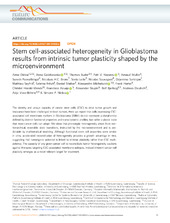Stem cell-associated heterogeneity in Glioblastoma results from intrinsic tumor plasticity shaped by the microenvironment
Dirkse, Anna; Golebiewska, Anna; Buder, Thomas; Nazarov, Petr V.; Muller, Arnaud; Poovathingal, Suresh K.; Brons, Nicolaas H. C.; Leite, Sonia; Sauvageot, Nicolas; Sarkisjan, Dzjemma; Seyfrid, Mathieu; Fritah, Sabrina; Stieber, Daniel; Michelucci, Alesandro; Hertel, Frank; Herold-Mende, Christel; Azuaje, Francisco; Skupin, Alexander; Bjerkvig, Rolf; Deutsch, Andreas; Voss-Böhme, Anja; Niclou, Simone Pierrette
Peer reviewed, Journal article
Published version

Åpne
Permanent lenke
https://hdl.handle.net/1956/22507Utgivelsesdato
2019-04-16Metadata
Vis full innførselSamlinger
Originalversjon
https://doi.org/10.1038/s41467-019-09853-zSammendrag
The identity and unique capacity of cancer stem cells (CSC) to drive tumor growth and resistance have been challenged in brain tumors. Here we report that cells expressing CSC-associated cell membrane markers in Glioblastoma (GBM) do not represent a clonal entity defined by distinct functional properties and transcriptomic profiles, but rather a plastic state that most cancer cells can adopt. We show that phenotypic heterogeneity arises from non-hierarchical, reversible state transitions, instructed by the microenvironment and is predictable by mathematical modeling. Although functional stem cell properties were similar in vitro, accelerated reconstitution of heterogeneity provides a growth advantage in vivo, suggesting that tumorigenic potential is linked to intrinsic plasticity rather than CSC multipotency. The capacity of any given cancer cell to reconstitute tumor heterogeneity cautions against therapies targeting CSC-associated membrane epitopes. Instead inherent cancer cell plasticity emerges as a novel relevant target for treatment.
